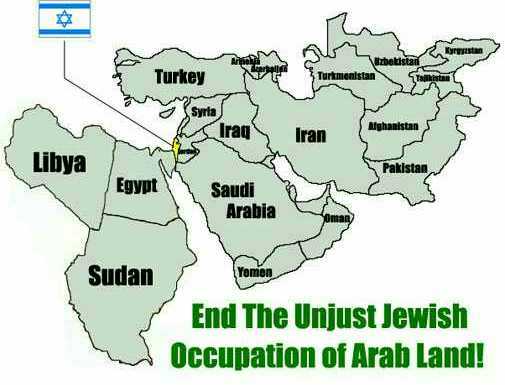Will (East) Jerusalem be the End of Two-State Illusion?
If the Arabs put down their weapons today, there would be no more violence.
If the Jews put down their weapons today, there would be no more Israel.
(In an email from the Baltimore Zionist Division)
Diplomacy is the art of conducting international relations with tact and skill in an effort to form alliances and agreements, whereas hypocrisy is the practice of professing false virtues. (Ophir Falk)
 Since last Gaza War on December 2008 the peace process of Israeli-Palestine conflict is going backwards again. Hamas is firing its qassams to Israel and Israel Defence Force responds; Palestine authority is still missing, Israel government has more hardliners than before and International community is making their hypocritical useless statements without any new initiative or an outline for the future; even U.S.-Israeli relations have declined due Israeli building projects in East Jerusalem.
Since last Gaza War on December 2008 the peace process of Israeli-Palestine conflict is going backwards again. Hamas is firing its qassams to Israel and Israel Defence Force responds; Palestine authority is still missing, Israel government has more hardliners than before and International community is making their hypocritical useless statements without any new initiative or an outline for the future; even U.S.-Israeli relations have declined due Israeli building projects in East Jerusalem.
 It should be remembered that in 1918, with the fall of the Ottoman Empire, Britain and France were handed more than 5,000,000 square miles to divvy up and 99% was given to the Arabs to create countries that did not exist previously. Less than 1% was given as a Mandate for the re-establishment of a state for the Jews on both banks of the Jordan River. In 1921, to appease the Arabs once again, another three quarters of that less than 1% was given to a fictitious state called Trans-Jordan. (Jack Berger, May 31, 2004.)
It should be remembered that in 1918, with the fall of the Ottoman Empire, Britain and France were handed more than 5,000,000 square miles to divvy up and 99% was given to the Arabs to create countries that did not exist previously. Less than 1% was given as a Mandate for the re-establishment of a state for the Jews on both banks of the Jordan River. In 1921, to appease the Arabs once again, another three quarters of that less than 1% was given to a fictitious state called Trans-Jordan. (Jack Berger, May 31, 2004.)
Settlements as dividing factor
A few years ago the people of Israel voted for a government that dismantled 10,000 Jewish homes in the hope for peace. The dismantlement led to disaster and instead of peace - Israeli civilians were targeted by Palestinian missiles. Last year the people of Israel voted for a government that wants to build homes rather than destroy them.
 The halt to settlement construction is a key demand by the Quartet of Mideast negotiators who are trying to restart negotiations between Israel and the Palestinians. Israel has agreed to curb settlement construction in the West Bank, but not in east Jerusalem, claiming the entire city as Israel's eternal capital.
The halt to settlement construction is a key demand by the Quartet of Mideast negotiators who are trying to restart negotiations between Israel and the Palestinians. Israel has agreed to curb settlement construction in the West Bank, but not in east Jerusalem, claiming the entire city as Israel's eternal capital.
Before discussing the settlements, Jerusalem and other final-status issues Palestinian Authority PA) should recognize Israel's basic right to exist as the national home of the Jewish people. After that the PA could come to an agreement with Israel, and finally set the border lines. Once the borders are set, then Israel will not support building of settlements in the PA area.
Settlements Established and Evacuated 1967-2008 -map (Foundation for Middle East Peace)
Jerusalem
The announcement of a routine planning approval for 1,600 dwellings in the East Jerusalem settlement neighborhood of Ramat Shlomo precipitated a crisis in U.S. - Israel relations, especially when information of project came during U.S. VP Bidens visit in Israel. U.S. as well later EU condemned this latest dwelling project and for Palestine Authority settlements are regular excuse to skip negotiations.
In a defiant speech last week to the leading pro-Israel lobby in the United States, Israel PM Netanyahu said Jewish neighbourhoods in East Jerusalem are "an integral and inextricable part of modern Jerusalem ... The connection between the Jewish people and Jerusalem cannot be denied ... The Jewish people were building Jerusalem 3,000 years ago, and the Jewish people are building Jerusalem today. Jerusalem is not a settlement. It is our capital".
East Jerusalem’ is not only the Old City. The eastern section of Jerusalem is larger than the western section (77 square kilometers vs. 45 square kilometers); it contains more than half the city`s residents, Jews and Arabs. In 1967, after occupying the West Bank, the Gaza Strip and the Golan Heights, the government of Israel annexed East Jerusalem and an additional tract of Palestinian land; Israel applied Israeli law to the eastern parts of the city, and granted residency rights to 66,000 Palestinians registered by census as its inhabitants. This status is different from citizenship: it does not enable its holders to participate in national elections and can be revoked at the discretion of the Ministry of Interior. Two legal systems apply to East Jerusalem residents: IHL (the laws of occupation), and Israeli law. (My source and more from JNews )
Jerusalem expansion plans -map (Foundation for Middle East Peace)
There was a Jewish majority in Jerusalem since 1860. Jews lived all over Jerusalem, and fought courageously in the War of Independence in 1948 to maintain their hold on it but in the end lost many lives and the east part of the city. That is when it was divided for the first time.
Israelis divide the Palestinians to five communities, as a means of control. There are the Israeli Palestinians, who are full Israeli citizens, enjoy the right to vote and have delegates in the Knesset. There are the East Jerusalemites who are not citizens, but have only resident permits and who are separated from the West Bank by the wall. There are the West Bank Palestinians who live in the five percent of the West Bank on the west side of the wall that Israel has, de facto, annexed to Israel, but who are also cut off from Jerusalem and forbidden to visit Israel. There are the West Bank Palestinians to the east of the wall. And there are the Palestinians in Gaza.
One vs. Two States
So far resolving the Palestinian-Israeli conflict has had two options on the top of agenda. The first is aim of two states for two peoples and the second is a bi-national Palestinian-Israeli state in which Palestinians and Israelis would have equal rights or a Palestinian-Israeli confederation, in which two states share joint political institutions – a one-sate option.
The two-state solution is becoming more and more impossible by the day as Israel continues to build more and more settlements on Palestinian lands. There is hardly enough land to form a viable Palestinian state at this time as it is. But judging by the actions of the settlement movement and its supporters, the one-state solution seems to be the preferred solution. However the Israeli and Palestinian definitions of a two state solution are very different. Palestinian idea of a two-state solution may be supported but only if the border is the 1967 border and refugees are given the right of return, an Israeli viewpoint can be different with these two aspects.
In Israel there is a group that believes that a bi-national state is inevitable because with Jewish and Palestinian communities so entangled in the West Bank, it will be almost impossible to divide them. However same time there is some base to claim that there is too much animosity and dehumanization among the Palestinian population that would make a peaceful co-existence between them and Israelis virtually impossible.
If one would like to take a cynical point of view so a de facto one state is the current reality on the ground. Israel rules all mandatory Palestine from Jordan to the Mediterranean. There is one regime based on ethnicity and security and Israeli control. Progress towards two-state solution seems unlikely.
Projection of Israel's West Bank Partition plan 2008 -map (Foundation for Middle East Peace)
Population transfers as pragmatic solution
If some ethnic groups hate each other and when both can base their views and claims to selected parts of hundreds or thousands of years so basically there only two peaceful solutions: to train tolerance for generations developing same time living conditions or separate the groups by ethnic lines.
After WWII Germans moved e.g. from Poland inside new borders. Finland settled some 10 % of its population from territories occupied by the Soviet Union, which from its side transferred new population to new regions. Israel itself is mainly settled by immigrants and e.g. in last twenty years over half a million people with some Jewish origin has come from ex-Soviet Union. In smaller scale more or less forced population transfers have been emptying Jewish colonies in Gaza. To be successful these kind of population transfers must be supported by effective re-settlement programmes.
| More or less forced population transfers (Data mostly taken from Ben-Dror Yemini, MidEast Truth Forum, January 15, 2009) Within less than a century, between 7 million and 10 million Balkan refugees have been uprooted from their homes. After WW2, between 12-16 million Germans were forced out of Sudentenland (Czechoslovakia), Romania, Hungary and Poland into Germany; many of them had not supported the Nazis during the war. 14 million people were exchanged between Hindu India and Moslem Pakistan. In 1994, 540,000 Moslems fled Christian Armenia for Azerbaijan and 360,000 Armenian Christians fled Azerbaijan for Armenia. As Israel did with the Jewish refugees from Arab countries, Armenia absorbed the Christian refugees, while — just like the Arab refugees from Israel — the Moslem refugees languish in Azerbaijani refugee camps. From the late '80s on, 75,000 non-Moslem blacks from Mauritania were exiled to Senegal and Mali, while 75,000 Arabs fled to Mauritania. Ethnic conflicts in the Sudan continue — between Muslim Arabs and black animists in the South; and between Muslim Arabs and black Muslims in Darfur. 3 t0 4 million black farmers of Darfur have fled Arab-dominated Khartoum, where some 200,000 to 400,000 black Muslims have already been killed. Cyprus has been split between Christian Greeks and Moslem Turks; this included a population exchange, where 200,000 Greeks and 50,000 Turks were shifted. Even before Israel became a state and increasingly after that, more than 800,000 Jews were forced to flee the Arab countries, where many of them had lived way before the Arabs Conquest; most of them came to Israel. When it became a state in 1948, Arabs left to avoid the coming war, fled in fear incited by their own press or were forced by their leaders to leave Israel. The Arabs claim 650,000-750,000 up to a million refugees, while the UN Acting Mediator in October, 1948 set it at 472,000, of which 360,000 required aid (UNRWA is now supporting 4.5 million of their "descendants".) Of all the refugees, only these Arabs have demanded the right of return. |
More about issues e.g. in my article “Gaza War – Could Balkan history show way out?”
Three-State Option?
I wonder why there is not more discussion about a “three-state” approach, where Gaza is returned to Egyptian control and the West Bank in some configuration reverts to Jordanian sovereignty. From my point of view this solution could also be more economically sustainable than other options. It could be a bit further developed by making a buffer zone between Israel and hard-liners in Gaza. From my point of view the best way to do this is to relocate population from Gaza some 50-100 km SW to Sinai. There is possible to build new infrastructure instead again repairing existing one. With good planning and implementing economic-social programmes backed with sufficient international Aid money it is possible also to create more sustainable economy than today’s Gaza. More in “The Three-State Option could solve Gaza Conflict”.
and hard-liners in Gaza. From my point of view the best way to do this is to relocate population from Gaza some 50-100 km SW to Sinai. There is possible to build new infrastructure instead again repairing existing one. With good planning and implementing economic-social programmes backed with sufficient international Aid money it is possible also to create more sustainable economy than today’s Gaza. More in “The Three-State Option could solve Gaza Conflict”.
My Conclusions
“If the EU would stop propping up Hamas and the PA with money and verbal support, there might actually be a chance of peace. Why should the Palestinians want to settle with Israel when they can line their pockets, buy the latest weaponry, and maintain their "clients" by holding out and continuing to receive support from the EU?” (Talkback Ynet)
The failure of U.S. in promoting the peace process between Israel and the Palestinians may be related to fact that again the plans are made on Washington's drawing board without understanding regional circumstances and mentality in the Middle East; the growing gap between reality and idealistic day-to-day politics is now demonstrated not only as strain in the U.S. Israel relationship but also as declining U.S. credibility among Palestinians.
The same – as U.S. foreign policy – can be said about EU's foreign policy (if one can found that some where). EU does not seems to have any vision nor strategy and initiatives for the Israeli-Palestinian peace process. Modest attempts to use carrots (squandering aid to capacity building in West bank and Gaza) and no use of sticks (e.g. embargo) reduce EU's foreign policy activities to empty statements ("The European Union has condemned all the settlement activities").
From my viewpoint the basic truth of the matter still stands: Israel is the only nation in the Middle East that holds free elections, enables freedom of speech and cherishes similar values to those of average European and American people. This said I must add that there is not only a conflict between Israelis and Palestinians, but a battle between those who believe in a mixed, tolerant and non-racial society, and the forces of ultra-nationalism in both Israel and Palestine.
The bottom line: Quality Peace
I would like to conclude that instead of rigid high-flown statements and dead road maps international community should facilitate the Middle East peace process through following three principles
- Negotiations will be restored without prior conditions.
- The talks should be implemented by local stakeholders, not under supervision of outside powers
- The international community – outside powers – should support any common agreed outcome of talks e.g. with financial aid programs
This approach means that an outcome – which I describe with term quality peace - is not possible to achieve imposed from top to field e.g forced by international community or other outsiders; with that kind of approach one can only freeze the conflict not solve it. The only way for quality peace is through motivation or at least commitment of individual, clan, community, ethnic groups, wider society or state to resolve conflicts through dialogue by acceptance and at least tolerance of differences. (More in my article “Quality Peace”)

Comments